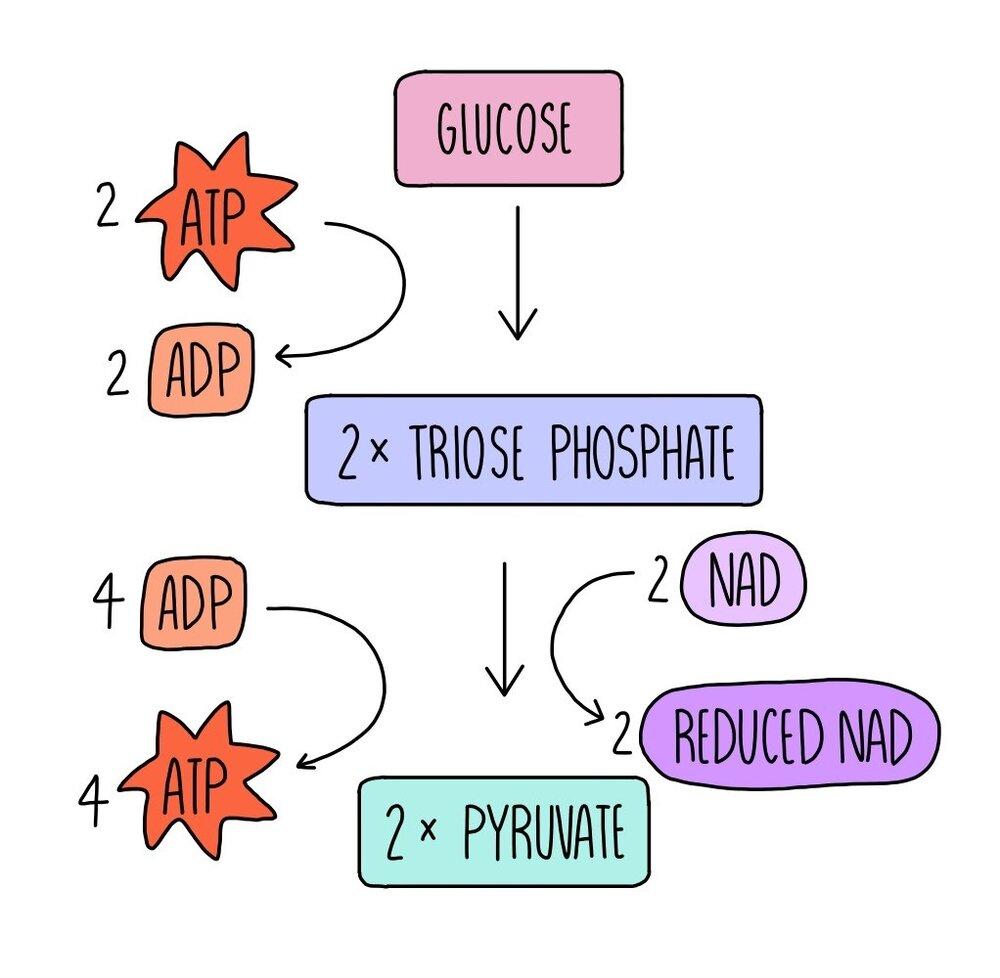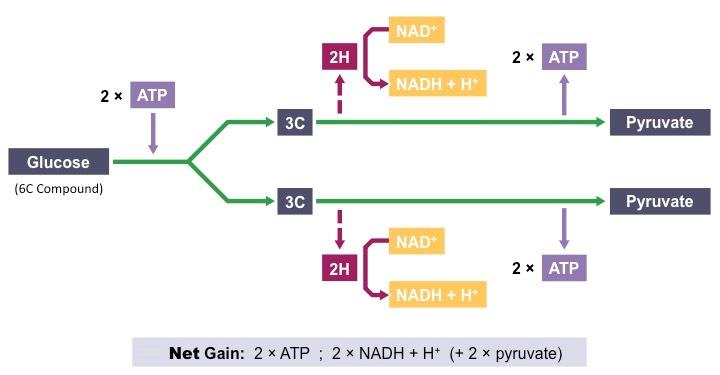Chapters
In this article, we will discuss the process of glycolysis in detail. We will especially discuss the phosphorylation of glucose and the subsequent splitting of fructose 1,6-bisphosphate (6C) into two triose phosphate molecules (3C), which are then further oxidized to pyruvate (3C), with the production of ATP and reduced NAD. But before discussing the process of glycolysis, first, let us recall the process of respiration. So, let us get started.

Respiration
Respiration refers to the set of processes and metabolic reactions that occur within the cells of the organism. It involves the storage of biochemical energy within ATP (Adenosine Triphosphate) molecules. ATP is produced rather than broken down as a result of the respiration process. There are two types of respiration: aerobic and anaerobic respiration.
Glycolysis is the first step of aerobic and anaerobic respiration which occurs in the cytoplasm of the cell. Glycolysis itself is an anaerobic process which means that it does not require oxygen.
In the case of anaerobic respiration, the pyruvate is transformed to lactate or ethanol by using a reduced NAD. This oxidized NAD can be further used in glycolysis. In the case of aerobic respiration, pyruvate from glycolysis enters the mitochondrial matrix through active transport. The detail of aerobic respiration is given below:
- The oxidation of pyruvate to acetate produces reduced NAD
- In the link reaction, the acetate combines with coenzyme A to produce acetyl-coenzyme A.
- A reaction of acetyl-coenzyme A with four carbon molecules release coenzyme A and produces six-carbon molecules that enter the Krebs cycle.
- The Krebs cycle produces reduced coenzymes and ATP by substrate-level Phosphorylation in a series of oxidation-reduction reactions. Carbon dioxide is lost.
- Oxidative phosphorylation synthesizes ATP which is connected to the electrons transfer down the electron transfer chain and passage of protons across the inner mitochondrial membranes which is then catalyzed by ATP synthase that are embedded in these membranes.
- Other respiratory substrates involve the breakdown products of amino acids and lipids, which enter the Krebs cycle.
In the next section of this article, we will discuss the process of glycolysis in detail.
Glycolysis – Introduction
The first step of cellular respiration which involves a sequence of reactions that break down carbohydrates into smaller molecules is referred to as glycolysis.
Generally, the process of glycolysis breaks down one glucose molecule and forms two pyruvate molecules along with the release of two ATP molecules. Glycolysis occurs in the majority of living organisms, although it is evolved with time. If we have to describe glycolysis in simple words, then we can just say that it refers to the splitting of sugars.
In the next section, we will discuss the steps of glycolysis along with their equations.
Steps of Glycolysis
Glycolysis has the following steps:
i. Phosphorylation
In this step, 2 ATP molecules phosphorylate glucose to create fructose biphosphate (6C). The equation of this stage is given below:
Glucose + 2ATP  Fructose bisphosphate
Fructose bisphosphate
ii. Lysis
This step involves the splitting of fructose biphosphate (6C) into two triose phosphate (3C) molecules.
Fructose bisphosphate  2 Triose phosphate
2 Triose phosphate
iii. Oxidation
This step of the glycolysis involves the removal of hydrogen from each triose phosphate molecule and its subsequent transfer to coenzyme NAD to form two reduced NAD.
4H + 2NAD  2NADH +
2NADH + 
iv. Dephosphorylation
This stage of glycolysis involves the transfer of phosphates from the intermediate substrate molecules to create four ATP through substrate-linked phosphorylation.
 + 4ADP
+ 4ADP  4ATP
4ATP
v. Production of Pyruvate
In this step, the end product of the glycolysis is produced which is then used in the next stage of respiration.
2 Triose phosphate  2 Pyruvate
2 Pyruvate

Glycolysis Process Explained
This section explains the glycolysis process in detail:
First, glucose is phosphorylated to glucose-6-phosphate using an enzyme known as hexokinase. This happens with the investment of an ATP molecule. Glucose-6-phosphate is then transformed into fructose-6-phosphate through an enzyme known as phosphoglucose isomerase. The next step involves another ATP-dependent interaction. In this stage, fructose-6-phosphate is converted onto fructose-1,6-biphosphate by an enzyme known as phosphofructokinase. Now, two phosphate groups are attached to this 6-carbon sugar.
2 3 carbon molecules use an enzyme known as aldolase to break down this molecule. The three-carbon molecules are dihydroxyacetone phosphate (DHAP) and glyceraldehyde-3-phosphate. An enzyme known as triosephosphate isomerase converts DHAP into glyceraldehyde-3-phosphate. Only glyceraldehyde-3-phosphate progresses to the subsequent stages of the reaction. By employing glyceraldehyde phosphate dehydrogenase, glyceraldehyde-3-phosphate is transformed to 1,3-bisphosphoglycerate. It also generates one NADH.
Next is the payoff phase. In this phase, phosphoglycerate kinase dephosphorylates 1,3-biphosphoglycerate to form 3-phosphoglycerate. This generates 1 ATP per reaction, Because there are 2 initial molecules, therefore 2 molecules of ATP are generated. Next phosphoglyceromutase transforms 3-phosphoglycerate into 2-phosphoglycerate, and then it is converted into phosphoenolpyruvate by an enzyme known as enolase. In the end, dephosphorylation of phosphoenolpyruvate occurs by pyruvate kinase to produce another ATP per molecule (2 ATP molecules are produced).

What happens at the end of glycolysis?
When glycolysis ends, there is a NET gain of two ATP molecules, two molecules of pyruvate, two molecules of ATP, and 2 molecules of NADH. Depending on the availability of oxygen, pyruvate can enter the mitochondria and can be oxidized to carbon dioxide by the cellular respiration process. It results in the release of high-energy electrons and several ATP molecules. In the case of the non-availability of oxygen, anaerobic respiration occurs and produces lactic acid.
In the next section of the article, we have explained the summary of the process in detail.
Summary of the process
- Glycolysis is a complicated process that occurs with the action of different enzymes and co-factors.
- It is the first pathway that is employed to derive energy from carbohydrates.
- This process has two parts: the first part needs the investment of ATP to provide energy to separate glucose into two 3 carbon sugars.
- ATP and electrons from hydrogen atoms are produced in the second half of the glycolysis process. These electrons are then attached to
 to produce NADH.
to produce NADH. - In the energy investment phase, two ATP molecules are invested, and four ATP molecules are created during the energy payoff phase. It results in the production of a net gain of two ATP and two NADH molecules for the cell.













Keep on teaching us,you are excellent teachers
This is great
Thanks a lot for this book,it really helped me a lot
It’s useful to me
Thanks a lot for your Better book!
It’s a perfect article, go ahead